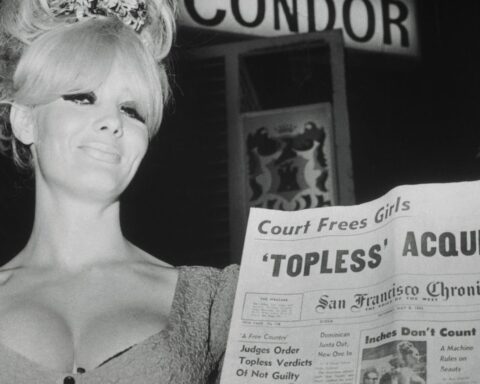Amy
(UK, 127 min.)
Dir. Asif Kapadia
Featuring: Amy Winehouse, Mitch Winehouse, Blake Fielder-Civil, Juliette Ashby, Lauren Gilbert
“Jules, this is so boring without drugs,” says Amy Winehouse during one of the many heartbreaking moments of Amy, the tragic documentary about the short but significant life and career of the British songstress. Amy Winehouse makes this sad lament for sobriety at a time when she should be celebrating. As her friend, Juliette Ashby, recounts in the film, Winehouse had just won a slew of Grammys including Record of the Year for “Rehab,” and, ironically, the star pulled her friend backstage and said that the night wasn’t the high it could have been since she had to experience it through the dull lens of clear-headedness. “Rehab” best defines the sad mass of contradictions that was the power and appeal of Amy Winehouse, but this shrewd archival doc by Asif Kapadia (Senna) breaks down the myth of Amy Winehouse and shows audiences how much they got her wrong.
“Rehab” remains the definitive Amy Winehouse song (although “Tears Dry on Their Own” is my personal favourite) in large part because it played into the perception that the singer was a wild hot mess. Her booze-fuelled concerts, notorious nights at the bars, and run-ins with paparazzi are stuff of rock and rock lore. (She could probably drink Jim Morrison under the table.) Her song was one of the definitive musical cues of 2007, especially for anyone at university that time. I have fuzzy memories of getting hammered at parties and swaying to “Rehab” with people I mostly know/remember through Facebook pictures I’ve long since untagged, spilling drinks and singing along with, “They tried to make me go to rehab, but I said ‘no, no, no’.” Plans for nights out included texts asking how drunk people wanted to get on a scale of one to Amy Winehouse. We loved Any Winehouse because her sultry, smoky voice was the life of the party and an anthem for university age kids who loved to get shit-faced. We loved Amy for her music and, especially, for the defiant hot mess we thought she was.
It’s hard to recover from Amy without having a slight sense of guilt that one essentially killed Amy Winehouse by loving the slurring train wreck of her star persona. Kapadia and editor Chris King take much of the footage that contributed to the Amy Winehouse myth and they re-contextualize it using audio interviews with friends and family that convey how much Winehouse struggled when she hit the peak of fame. The film features old archival footage of Amy during her childhood and teen years in which her talent and lust for life are plainly evident. She looked like the life of the party, but the film shows how the party changed over the course of her career.
Winehouse, a member of the infamous “27 Club” populated by stars who died too soon, had a great voice and Amy shows her eclectic mix of jazz, pop, and soul with a range of showstopping performances. Behind the scenes footage reveals her creative process as she records songs like Back to Black and the best excerpts of her concerts showcase an original voice that was a force of nature. Amy tragically portrays Winehouse as an unparalleled talent that fell short of her potential with a tragic waste.
Amy features as much footage of Winehouse battling the bottle as it does of her performing and writing songs. These images rarely show Amy having a good time: she’s loaded to the point of incoherence in some shots, while she’s violent and miserable in others. Her addiction to drugs and her struggle with bulimia show a person who lost control and never quite knew how to take care of herself: she went straight from adolescence to stardom, and the accounts with her friends suggest that she didn’t experience the same transition period they did in which they learned to become adults. Winehouse continued to party, but with bigger and better poisons that she could now afford.
This footage of Winehouse is to some extent limiting as Amy defines Winehouse as much by her alcoholism as it does by her musical talent. This aspect of Winehouse’s persona is admittedly inextricable since it shaped her life and work, but it also doesn’t entirely erase the perception of Winehouse that existed in the public eye. Instead of a hedonistic hot mess, however, Amy presents Winehouse as a full-throttle rager with a death wish. The reliance on archival footage does little new as it re-examines its subject from a variety of sources (mostly low-res digital video) and while it’s flawlessly made, the archival montage never quite approaches the phenomenal meta-meditation on Kurt Cobain in this year’s Montage of Heck nor does the limited scope of the film doesn’t take Winehouse’s story to the same level that Liz Garbus does with the troubled Nina Simone in What Happened, Miss Simone?. Amy hardly has a fault to its astute collage of a great, tortured talent, but it inevitably leaves something to be desired in a year that already has some great docs about musical geniuses elevating the art form.
The film really succeeds, though, as it culls through the elements of media that contributed to Winehouse’s death. The film builds an assaultive montage of villainous paparazzi flash bulbs that obscure the singer as she tries to live a private life. Kapadia raises the volume of the cameras to the volume of a beast and turns jokes about Winehouse’s addiction back on the insensitivity of the talking heads, and Amy argues that the public’s desire to feed on the mess of Winehouse’s life trapped the singer in a self-destructive cycle she could not escape. The film puts the onus of Winehouse’s death on all of us as it boldly implies that her death by alcohol poisoning was on some level a suicide, for she hit the bottle a final time as an escape from the all-consuming curse of celebrity. Amy heartbreakingly celebrates a talent lost too soon and incisively cuts at the celebrity culture that makes victims of its own stars.











